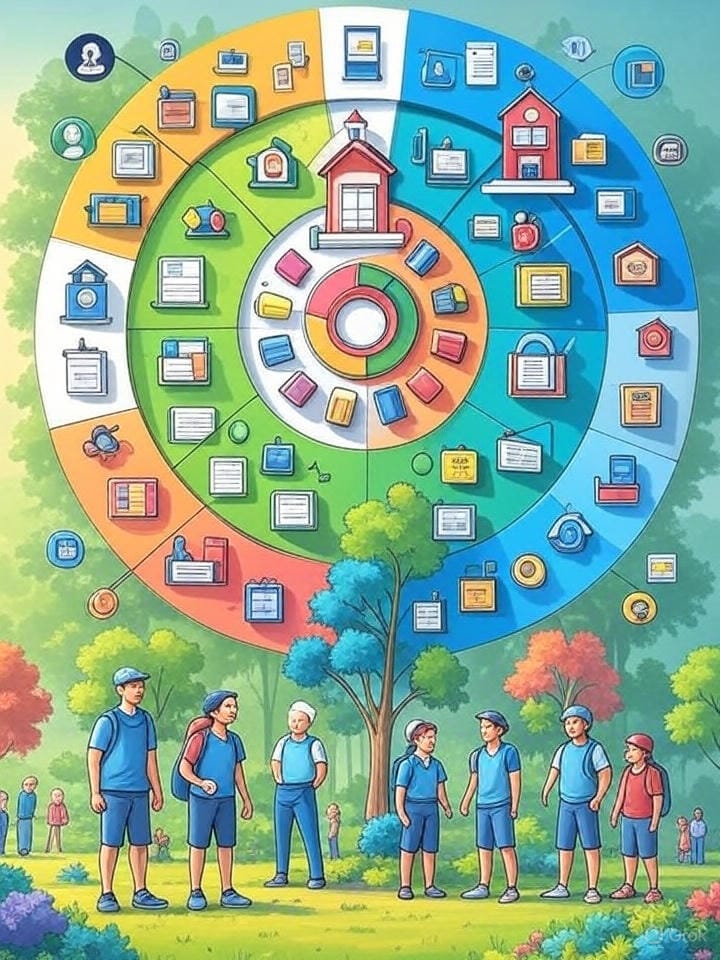Budgets are an Important Tool in Accounting for Fundraisers
Who does the accounting for school fundraisers? Is there a treasurer? Is it the leader of the PTO? Every school fundraiser should have an accountant. Many fundraisers don't do any accounting besides collecting money, and putting it in a bank account, or spending it on supplies. Most states have a bevy of structured policies around fundraising for classrooms or student support organizations (SSO) that dictate the use of school facilities for fundraising purposes that include the use of the school logo, what is included in accounting for fundraisers, what forms need to be submitted, the goals and objectives of the SSO. and more than you might imagine. But one thing for certain—every school fundraiser needs an operational plan and a budget.
Track Every Dollar — Then Let Them Multiply
You’re focused on audits, spreadsheets, and transparency. Now use a fundraising platform that simplifies accounting and boosts revenue — launch your auction with built-in reporting and donor tracking.
Launch Your Audit-Ready AuctionBudgets
Budgets for school fundraisers are just as important in accounting for school fundraisers as important as accounting for a large, for-profit company. Budgeting is for the effective administration of your school fundraiser. Budgets help you plan and measure results. They are a guide to help you understand what works and what is not working. Understanding what helps you accomplish your goals is key to running an effective school fundraiser or non-profit.
A good budget will make projections of revenue and expenses based on several criteria. Past revenue and expenses can give you a good idea of what to expect for the next fiscal year. If you keep good accounting records for your school fundraiser, the next person in charge can build off of that knowledge. If you are a new organization, this information will, of course, not be available to you. It can be helpful to look at income statements from peers or similar organizations to get an idea of what kind of income and expenses you may expect.
In addition to looking at the past, keeping an eye on the future will assist you in coming up with a realistic budget. Take a look at the trends in the world around you. Are prices rising? If there is a recession, will contributions decline? Is there something new out there that may compete for the dollars normally going to your organization? Are you embarking on a new marketing campaign that is expected to boost contributions? Think about what could contribute to increased or decreased income and expenses, and account for that in your projections.
Checking Performance
Once you have a realistic budget in place, it becomes an invaluable tool for analysis to measure how your organization is performing.
- Comparing revenue and expenses to what is budgeted provides insight into the efficiency of the courses of action taken.
- Seeing if income matches your projections allows you to evaluate how well you are reaching contributors.
- Monitoring expenses against what was budgeted will show if your costs are being kept under control. It tells you what might need to be investigated further. Has a vendor raised prices? Are you using too much when less would do? Is there waste when there need not be? Monitoring costs in this fashion also helps to identify fraud. An expense over budget can be a tip that some purchases were not approved.
Charitable organizations strive to be good stewards of the contributions entrusted to them. A well-prepared budget will help you achieve this goal. Most accounting software will have budgeting tools available. If you are small enough that you don’t use accounting software, an Excel spreadsheet will suffice, or it can even be handwritten in a ledger.
Take the time to get a budget in place before you begin your school fundraiser, and use it as a tool to guide your organization to be successful in its mission. CharityAuctionsToday can help you track your fundraising efforts with our online auction software.
Take a test drive of our online auction software. It's an easy way to fundraise.
Frequently Asked Questions
What does “accounting for school fundraisers” include?
It covers budgeting, cash handling, recording income/expenses, reconciling deposits, acknowledging donors, tracking restrictions, and reporting results to school leaders, boards, and supporters.
Who “owns” the money—school or PTA/PTO/booster club?
If the fundraiser is run by an independent PTA/PTO/booster (its own bank account and EIN), they generally hold and account for the funds. If the school or district runs it, funds usually belong to the school (often in a student activity account). Confirm your local policies. General information, not legal advice.
What accounts should we set up to track a fundraiser properly?
- Income: ticket sales, donations, sponsorships, auction sales, merchandise.
- Cost of fundraising: venue, food, printing, software/processing fees, prizes.
- In-kind: donated goods/services (record value separately).
- Restrictions: separate class or project code for restricted gifts.
How do we budget and approve spending for a school fundraiser?
- Create a simple P&L forecast (goal, expected revenue, direct costs, net).
- Get approval from the principal/board/committee before spending.
- Set spending limits and required documentation for reimbursements.
What cash-handling controls should we use at events? (General information)
- Two unrelated counters for opening/closing cash and sealed drop bags.
- Pre-numbered receipt books or POS reports; no IOUs from cash boxes.
- Daily deposit—never take cash home; reconcile to logs the same day.
General information only.
How do we reconcile deposits after the fundraiser? (General information)
- Match cash/check logs and POS totals to bank deposit slips.
- Reconcile platform payouts (online payments) to the bank statement.
- Document discrepancies and have a second person sign off.
General information only.
How should we record online payments and processing fees? (General information)
Record gross revenue and record processing fees separately as an expense, even if payouts arrive net of fees. Retain platform statements for audit trails. General information, not financial advice.
Do we need to collect sales tax on items or tickets? (General information)
Rules vary by location and by what you sell (tangible goods, meals, admissions). Some school or nonprofit sales may be exempt or limited. Check local regulations or a qualified advisor. General information, not tax advice.
What belongs on donor receipts and acknowledgments? (General information)
- Date, amount (or description for in-kind), and organization information.
- Whether any goods/services were provided in return (see quid pro quo).
- Thank-you message and contact info for questions.
General information, not tax advice.
How do auction purchases affect donor receipts and FMV? (General information)
List the fair market value (FMV) of each item. If the winning bid exceeds FMV, only the amount above FMV may be potentially deductible for the buyer. Provide FMV and amount paid on receipts. General information, not tax advice.
How do we record in-kind donations of goods or services? (General information)
Record a reasonable value and an equal expense (if used) so results reflect the true cost of the event. Acknowledgments typically describe the donation but may not state value for certain services. General information, not tax advice.
What’s the difference between a sponsorship and a donation? (General information)
Donations have no significant benefits provided to the giver. Sponsorships often include benefits (ads, signage, tables). Track separately and disclose benefits on acknowledgments. General information, not tax/legal advice.
How should we track restricted fundraising (e.g., band uniforms)? (General information)
Create a separate class/project code for the restriction. Record revenue and related expenses against that code and report balances until the purpose is fulfilled. General information only.
What’s a clean process for volunteer/staff reimbursements? (General information)
- Pre-approval for purchases above a set amount.
- Submit itemized receipts within a stated timeframe.
- Two signatures for checks or electronic approvals for ACH.
General information only.
What documentation should we keep and for how long? (General information)
- Budgets, approvals, contracts, donation forms, item lists, FMV support.
- Deposit records, bank statements, payout reports, reconciliations.
- Receipts/acknowledgments and volunteer cash-count sheets.
Follow your organization’s retention policy. General information only.
How should we report results to families and sponsors? (General information)
Share a simple report within 1–2 weeks: total raised, net after costs, what the money will fund, and a thank-you list (as appropriate). Use clear graphics and a short impact story. General information only.
Anything special at year-end for school fundraising groups? (General information)
Close out accounts, reconcile bank balances, prepare annual reports for your board or school, and complete required filings (if any) for your entity type. Independent PTAs/PTOs/boosters may have different requirements than school-run accounts. General information, not tax/legal advice.
What if funds flow through a student activity account? (General information)
Follow district procedures for deposits, approvals, and purchases. Keep supporting documentation and reconcile with the campus bookkeeper. General information only.
How do we reduce risk of errors or fraud? (General information)
- Separate duties: one collects, another records, another reconciles.
- Use dual signatures for checks and admin-only access to banking.
- Review monthly financials with the principal/board/treasurer.
General information only.
What should our post-event P&L and KPIs include? (General information)
- Gross revenue by source (tickets, donations, auction, merch).
- Direct costs, net revenue, and % cost to raise a dollar.
- Attendance, average gift, items with ≥2 bids, and sponsor ROI notes.
Use these insights to refine next year’s plan. General information only.
What common mistakes should we avoid, and is there a quick checklist?
- Avoid: commingling funds, weak cash controls, missing FMV, and late deposits.
- Checklist: approve budget → set controls → log all income → deposit daily → reconcile to bank & platform → issue acknowledgments → share results → file/retain docs.
💡 Try this in ChatGPT
- Summarize the article "Accounting for School Fundraisers" from https://ghost.charityauctionstoday.com/p/accounting-for-school-fundraisers/ in 3 bullet points for a board update.
- Turn the article "Accounting for School Fundraisers" (https://ghost.charityauctionstoday.com/p/accounting-for-school-fundraisers/) into a 60-second talking script with one example and one CTA.
- Extract 5 SEO keywords and 3 internal link ideas from "Accounting for School Fundraisers": https://ghost.charityauctionstoday.com/p/accounting-for-school-fundraisers/.
- Create 3 tweet ideas and a LinkedIn post that expand on this Schools topic using the article at https://ghost.charityauctionstoday.com/p/accounting-for-school-fundraisers/.
Tip: Paste the whole prompt (with the URL) so the AI can fetch context.
Tom Kelly
Tom Kelly is a nonprofit strategist, bestselling author of Million Dollar Nonprofit, and CEO of CharityAuctionsToday. Dedicated to helping organizations scale through AI and automation.
Table of contents
Create Your Auction
Raise 40% more with smart bidding tools






